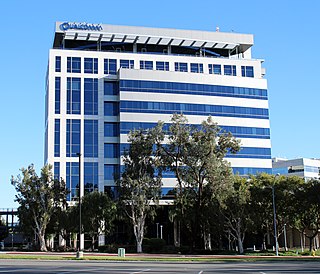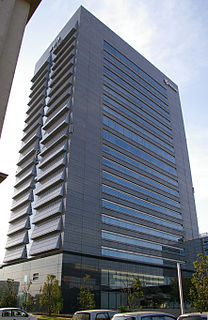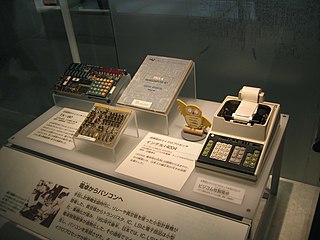Related Research Articles

Intel Corporation is an American multinational corporation and technology company headquartered in Santa Clara, California, in Silicon Valley. It is the world's largest semiconductor chip manufacturer on the basis of revenue, and is the developer of the x86 series of microprocessors, the processors found in most personal computers (PCs). Incorporated in Delaware, Intel ranked No. 46 in the 2018 Fortune 500 list of the largest United States corporations by total revenue.
N-type metal-oxide-semiconductor logic uses n-type (-) MOSFETs to implement logic gates and other digital circuits. These nMOS transistors operate by creating an inversion layer in a p-type transistor body. This inversion layer, called the n-channel, can conduct electrons between n-type "source" and "drain" terminals. The n-channel is created by applying voltage to the third terminal, called the gate. Like other MOSFETs, nMOS transistors have four modes of operation: cut-off, triode, saturation, and velocity saturation.

Qualcomm is an American multinational corporation headquartered in San Diego, California, and incorporated in Delaware. It creates intellectual property, semiconductors, software, and services related to wireless technology. It owns patents critical to the CDMA2000, TD-SCDMA and WCDMA mobile communications standards.

Kyocera Corporation is a Japanese multinational ceramics and electronics manufacturer headquartered in Kyoto, Japan. It was founded as Kyoto Ceramic Company, Limited in 1959 by Kazuo Inamori and renamed in 1982. The company has diversified its founding technology in ceramic materials through internal development as well as strategic mergers and acquisitions. It manufactures industrial ceramics, solar power generating systems, telecommunications equipment, office document imaging equipment, electronic components, semiconductor packages, cutting tools, and components for medical and dental implant systems.

Busicom was a Japanese company that owned the rights to Intel's first microprocessor, the Intel 4004, which they created in partnership with Intel in 1970.
SRAM LLC is a privately owned bicycle component manufacturer based in Chicago, Illinois, United States, founded in 1987. SRAM is an acronym comprising the names of its founders, Scott, Ray, and Sam,. The company is known for producing cycling components, including some internally developed, such as Grip Shift, EAGLE (1x12), DoubleTap, dedicated 1x11 mountain and road drivetrains and SRAM Red eTap.
Embedded DRAM (eDRAM) is dynamic random-access memory (DRAM) integrated on the same die or multi-chip module (MCM) of an application-specific integrated circuit (ASIC) or microprocessor. eDRAM's cost-per-bit is higher when compared to equivalent standalone DRAM chips used as external memory, but the performance advantages of placing eDRAM onto the same chip as the processor outweigh the cost disadvantages in many applications. In performance and size, eDRAM is positioned between level 3 cache and conventional DRAM on the memory bus, and effectively functions as a level 4 cache, though architectural descriptions may not explicitly refer to it in those terms.
ASML is a Dutch multinational company specializing in development and manufacturing of photolithography systems. Currently it is the largest supplier of photolithography systems for the semiconductor industry. The company manufactures machines for the production of integrated circuits.
Hon Hai Precision Industry Co., Ltd., trading as Foxconn Technology Group and better known as Foxconn, is a Taiwanese multinational electronics contract manufacturer with its headquarters in Tucheng, New Taipei City, Taiwan. In 2010, it was the world's largest provider of electronics manufacturing services and the third-largest technology company by revenue. The company is the largest private employer in Taiwan and one of the largest employers worldwide. Terry Gou is the company's founder and former chairman.
In the microelectronics industry, a semiconductor fabrication plant is a factory where devices such as integrated circuits are manufactured.
The 14 nm process refers to the MOSFET technology node that is the successor to the 22 nm node. The 14 nm was so named by the International Technology Roadmap for Semiconductors (ITRS). Until about 2011, the node following 22 nm was expected to be 16 nm. All 14 nm nodes use FinFET technology, a type of multi-gate MOSFET technology that is a non-planar evolution of planar silicon CMOS technology.
The 3 μm process is the level of MOSFET semiconductor process technology that was reached around 1977, by leading semiconductor companies such as Intel.
The 10 μm process is the level of MOSFET semiconductor process technology that was commercially reached around 1971, by leading semiconductor companies such as RCA and Intel.
The automotive industry crisis of 2008–2010 was a part of the financial crisis of 2007–2008 and the resulting Great Recession. The crisis affected European and Asian automobile manufacturers, but it was primarily felt in the American automobile manufacturing industry. The downturn also affected Canada by virtue of the Automotive Products Trade Agreement.
In semiconductor manufacturing, the International Technology Roadmap for Semiconductors defines the 7 nm process as the MOSFET technology node following the 10 nm node. It is based on FinFET technology, a type of multi-gate MOSFET technology.

Wyman-Gordon is a company that designs and manufactures complex metal components. Founded in 1883 as a manufacturer of crankshafts for looms, it has a long history of making forged metal components, particularly for the aerospace industry. Wyman-Gordon is now a subsidiary of Precision Castparts Corp., and is based in Houston, Texas. It has 13 plants in five countries, and employed about 2,500 people as of 2012.

Brian Matthew Krzanich is an American engineer and businessman currently serving as the chief executive officer of CDK Global. Krzanich joined Intel as an engineer in 1982 and served as chief operating officer (COO) before being promoted to CEO. As CEO, Krzanich was credited for diversifying Intel's product offerings and workforce. However, during Krzanich's term as CEO, Intel went through major restructurings and pulled out of the mobile chip market. Because of Krzanich's decisions, Intel also struggled to produce 10-nanometer chips, compared to chip manufacturers TSMC and Samsung, resulting in numerous delays and a loss of market share in the computer chip business to rivals like AMD.

The automotive industry in Egypt has been developing for 50 years. It can sell more than 200,000 vehicles annually and is now the second-largest market in Africa and the 42nd largest in the world, with an annual production output of over 70,000 vehicles. After experiencing many failures and success, the Egyptian Automotive industry is more focussing on assembly operations, rather than manufacturing.
Tsinghua Unigroup is a Chinese semiconductor manufacturer that also supplies digital infrastructure and services to domestic and global markets. Based in Beijing, it is among the country’s largest technology conglomerates; subsidiaries include UNISOC, China’s largest mobile phone chip designer. Other core subsidies design and manufacture network equipment and server and storage products, and produce system integration, network security and software applications.
References
- ↑ "Chip Shortage Spurs Japanese Workers to Forgo Vacations". LA Times. Retrieved 2012-05-01.
- ↑ Magee, Mike (2000-01-06). "Gateway to use AMD because of Intel chip famine". The Register. Retrieved 2010-01-05.
- ↑ Malik, Om (2004-05-10). "CDMA chip shortage developing?". gigaom. Retrieved 2012-05-05.
- ↑ Patrizio, Andy (2021-01-06). "You're not imagining things, there is a serious chip shortage". Network World. Retrieved 2021-01-18.
- ↑ "Chip-shortage 'crisis' halts car-company output". BBC News. 2021-01-18. Retrieved 2021-01-18.
- ↑ "Chip Shortage Strains Computer Makers". LA Times. Retrieved 2012-05-01.
- ↑ "Real Chip Shortage Or Just A Panic, Crunch Is Likely To Boost Pc Prices". Chicago Tribune. Retrieved 2012-05-01.
- ↑ "Electronics industry fears chip shortage/Dearth of factories may drive up prices". AP. Retrieved 2012-05-01.
- ↑ Nystedt, Dan. "Electronics industry fears chip shortage/Dearth of factories may drive up prices Intel laptop chip shortage worsens". IDG. Retrieved 2012-05-01.
- ↑ Pollack, Andrew. "Shortage of Memory Chips Has Industry Scrambling". NY Times. Retrieved 2012-05-01.
- ↑ Pollack, Andrew. "Chip Pact Falls Short of Goals". NY Times. Retrieved 2012-05-01.
- ↑ Lazzareschi, Carla. "High-Tech Crisis Forces Publishers to Make Tough Choices : Shortage of Memory Chips Hurting Video Game Makers". LA Times. Retrieved 2012-05-01.
- ↑ "Nintendo unable to ramp up Wii production". Digitimes. Retrieved 2012-05-01.